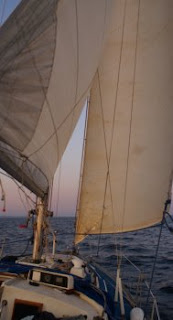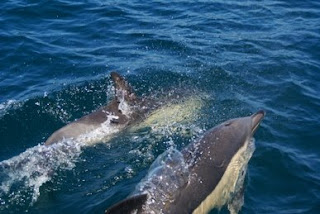After our last unsuccessful day, we were at the edge fo our time constraint and it was time to move back to Portimão. Usually, this crossing would be done in two steps, a longer one from Sines to Sagres, moving to Portimão only in the next day. However, all of us had time constraints, so we were going to try and do it all in one go. This meant we needed to do aproximately 80 miles straight, without stoping. The forecast was promising. A quiet west wind for a start, increasing and turning North during the afternoon. I tell everyone we are leaving at 0500 sharp, otherwise we'll get to Portimão quite late. When I woke up, however, the port was covered in the most thick fog (where have we seen this before?!)! I tell everyone we should wait for the fog to lift as it is dangerous to leave such a busy port as Sines like this. Questioned what about getting late to Portimão, I reply that if we get to Sagres tired, we can stay in Sagres and leave to Portimão the next day. Mafalda, however, could no afford to do this, as she needed to be home at a specific time. As such I advise her to take a bus that day, as the only thing I was able to assure was a safe crossing, not a "on time" crossing! She eventually did, and so that left only me, Pedro and Margarida. At aroun 0900 the fog was thicker than ever and it was the time to make a decision. We would either leave, or risk having to wait for the next day. Fortunately, contrary to our other foggy experiences, I now had set up a radar on the boat. I got a good deal on a used one, and had set it up a few days before with the help of my brother. It was time to make use of it.
At 0930 we leave Sines harbour under the thickest fog, not being able to see more than just a few metres. We never even saw the port pontoons! We were navigating by radar, and radar only. As we leave the prot limitis I set a 3 mile radius alarm around our boat to make sure we would not be caught by surprise. However, the only thing that crossed our way were some fishermen buoys,and at aroun 1200 the fog started to lift. We started on engine with no wind, but soon we had a slight breezecoming from the southwest. We hoist sails andaided by the engine were doing a very nice 6 knots average. The sea was brilliant, everyone was very comfortable having a great time sailing along the Vincentine coast. At around 1800 we start seeing cape St. Vincent, and at around 1900 we were crossing it with a previledged view of its lighthouse, the second most powerful in Europe, with a range of 60 miles and guardin on of the busiest shipping lanes in the world!



After we crossed the cape, the wind picked up and we were soon only on sail, doing between 6 and 7 knots. At this point, Margarida asked if we were staying at Sagres or continuing to Portimão. "You tell me. How are you feeling? Tired?" I replied. Both of them told me thwy were feeling good. "Lets keep going then. No point in stopping!" And so we left cape St. Vincent behind now steadily sailing towards Portimão.


Soon enough we were sailing in the sunset...
... then in the dusk...
... and finally, into the night!
At this point, Margarida went down to cook us some dinner. AS this was the final day, there wasn't much left to eat, but she was still able to gather some things and cook a very nice dinner! We ate dinner as we greeted the first stars to come around. Eventually, the only light we could see were the light from the villages along the coast, and given it was full moon, we could clearly see every star in the sky striped by the milky way. Accompanying us was on sailing boat that was sailing a bit faster and stoped at Lagos, and a motorboat that was being outrun by both sailing boats! Sailing is still the most effective way of transport on the sea!!!
Soon we crossed Ponta da Piedade and we were sailing inside the Portimão bay. Wind was unsteady which forced us to some sail changes, but nothing special. As we were aproaching the entrance of the Portimão marina, I heard this very familiar sound. "Guys, I think we have dolphins!" I say. "Oh, come on. You're just pulling our legs!" said Margarida as on of them surface just beside us! We were being followed by a group of 6-8 dolphins. As it was dark we could barely see them, but we could see the trails they left behind as the agitation they caused while swimming caused the fluorescent algae to light up. They looked like fast invisible torpedoes cruising along side us. Suddenly I look up and see a fireworks display startin in a nearby village. We were sailing into port at night, with dolphins following us and a firework display... fieldseason 2008 was finishing in the most glorious way!!! As we are aproaching the port entrance, the wind suddenly drops completely, almost as helping us to put the sails down. At 0100 we moored at the Portimão marina. I look at the handheld GPS to turn it off for the last time this year. I turn to Pedro and Margarida and say "At 2343 miles, fieldwork for 2008 ends. Now I can rest...".













































